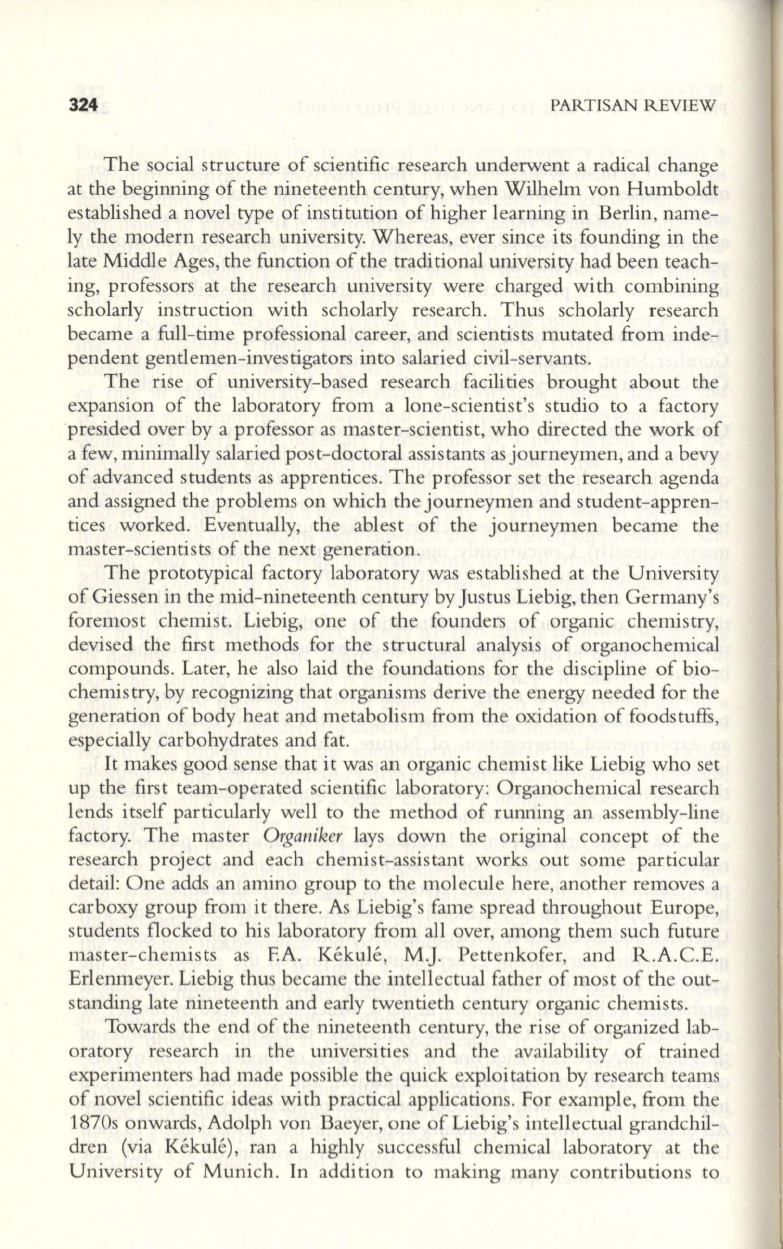
324
PARTISAN REVIEW
The social structure of scientific research underwent a radical change
at the beginning of the nineteenth century, when Wilhelm von Humboldt
established a novel type of institution of higher learning in Berlin, name–
ly the modern research university. Whereas, ever since its founding in the
late Middle Ages, the function of the tradi tional university had been teach–
ing, professors at the research university were charged with combining
scholarly instruction with scholarly research. Thus scholarly research
became a full-time professional career, and scientists mutated from inde–
pendent gentlemen-investigators into salaried civil-servants.
The rise of university-based research facilities brought about the
expansion of the laboratory from a lone-scientist's studio to a factory
presided over by a professor as master-scientist, who directed the work of
a few, minimally salaried post-doctoral assistants as journeymen, and a bevy
of advanced students as apprentices. The professor set the research agenda
and assigned the problems on which the journeymen and student-appren–
tices worked. Eventually, the ablest of the journeymen became the
master-scientists of the next generation.
The prototypical factory laboratory was established at the University
of Giessen in the mid-nineteenth century by Justus Liebig, then Germany's
foremost chemist. Liebig, one of the founders of organic chemistry,
devised the first methods for the structural analysis of organochemical
compounds. Later, he also laid the foundations for the discipline of bio–
chemis try, by recognizing that organisms derive the energy needed for the
generation of body heat and metabolism from the oxidation of foodstuffs,
especially carbohydrates and fat.
It makes good sense that it was an organic chemist like Liebig who set
up the first team-operated scientific laboratory: Organochemical research
lends itself particularly well to the method of running an assembly-line
factory. The master
Organiker
lays down the original concept of the
research project and each chemist-assistant works out some particular
detail: One adds an amino group to the molecule here, another removes a
carboxy group from it there. As Liebig's fame spread throughout Europe,
students flocked to his laboratory from allover, among them such future
master-chemists as FA. Kekule, M.J. Pettenkofer, and R.A.C.E.
Erlenmeyer. Liebig thus became the intellectual father of most of the out–
standing late nineteenth and early twentieth century organic chemists.
Towards the end of the nineteenth century, the rise of organized lab–
oratory research in the universities and the availability of trained
experimenters had made possible the quick exploi tation by research teams
of novel scientific ideas with practical applications. For example, from the
1870s onwards, Adolph von Baeyer, one of Liebig's intellectual grandchil–
dren (via Kekule), ran a highly successful chemical laboratory at the
University of Munich. In addition to making many contributions to


